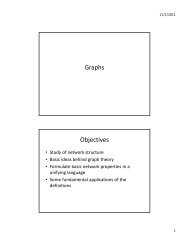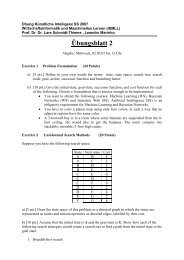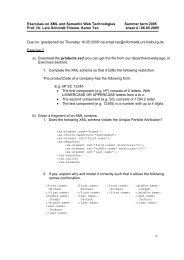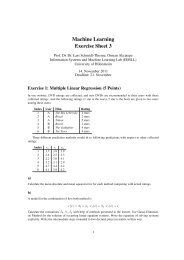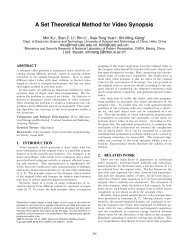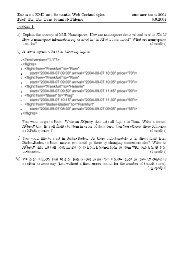Machine Learning 3. Nearest Neighbor and Kernel Methods - ISMLL
Machine Learning 3. Nearest Neighbor and Kernel Methods - ISMLL
Machine Learning 3. Nearest Neighbor and Kernel Methods - ISMLL
You also want an ePaper? Increase the reach of your titles
YUMPU automatically turns print PDFs into web optimized ePapers that Google loves.
<strong>Machine</strong> <strong>Learning</strong> / <strong>3.</strong> Parzen Windows<br />
k-<strong>Nearest</strong> <strong>Neighbor</strong> is locally constant<br />
In k-nearest neighbor the size of the window varies from<br />
point to point: it depends on the density of the data:<br />
in dense parts<br />
the effective window size is small,<br />
in sparse parts<br />
the effective window size is large.<br />
Alternatively, it is also possible to set the size of the<br />
windows to a constant λ, e.g.,<br />
{ 1, if |x − x0 | ≤ λ<br />
K λ (x, x 0 ) :=<br />
0, otherwise<br />
Lars Schmidt-Thieme, Information Systems <strong>and</strong> <strong>Machine</strong> <strong>Learning</strong> Lab (<strong>ISMLL</strong>), Institute BW/WI & Institute for Computer Science, University of Hildesheim<br />
Course on <strong>Machine</strong> <strong>Learning</strong>, winter term 2007 36/48<br />
<strong>Machine</strong> <strong>Learning</strong> / <strong>3.</strong> Parzen Windows<br />
<strong>Kernel</strong> Regression<br />
Instead of discrete windows, one typically uses<br />
continuous windows, i.e., continuous weights<br />
K(x, x 0 )<br />
that reflect the distance of a training point x to a<br />
prediction point x 0 , called kernel or Parzen window,<br />
e.g.,<br />
{<br />
1 −<br />
|x−x 0 |<br />
K(x, x 0 ) :=<br />
λ<br />
, if |x − x 0 | ≤ λ<br />
0, otherwise<br />
Instead of a binary neighbor/not-neighbor decision, a<br />
continuous kernel captures a “degree of neighborship”.<br />
<strong>Kernel</strong>s can be used for prediction via kernel<br />
regression, esp. Nadaraya-Watson kernel-weighted<br />
average:<br />
∑<br />
(x,y)∈X<br />
ŷ(x 0 ) :=<br />
K(x, x 0)y<br />
∑<br />
(x,y)∈X K(x, x 0)<br />
Lars Schmidt-Thieme, Information Systems <strong>and</strong> <strong>Machine</strong> <strong>Learning</strong> Lab (<strong>ISMLL</strong>), Institute BW/WI & Institute for Computer Science, University of Hildesheim<br />
Course on <strong>Machine</strong> <strong>Learning</strong>, winter term 2007 37/48




